|
Reflections of Our Past: The Archaeology of South Carolina
What is Archaeology?
Archaeology is the scientific study of our past through the careful
excavation and thorough analysis of material objects, or artifacts, and
other evidence preserved in the ground. Through the detailed process of site
discovery, excavation, laboratory analysis and research, archaeologists are
able to reconstruct how Native Americans, Euro-Americans, and African
Americans lived before us. Archaeology tells us not only about the wealthy
and powerful, but also how the common people spent their lives in South
Carolina. Without archaeology, we would know much less about the rich and
varied heritage of our State and about our past. Archaeology, like history,
provides us with ties to the past and hopes for the future.
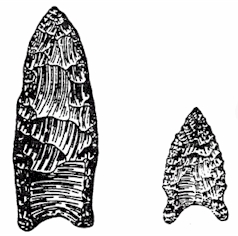 The First South
Carolinians: The Paleoindians (12,000 B.C. to 8,000 B.C.) The First South
Carolinians: The Paleoindians (12,000 B.C. to 8,000 B.C.)
The earliest inhabitants of South Carolina were the descendants of Asian
emigrants who crossed into North America from Siberia about 14,000 years ago
(maybe even earlier). These people, called
Paleoindians, followed the
gradual movement of large game animals across a land bridge connecting Asia
and North America. This passageway, called Beringia, was exposed when the
late Pleistocene glaciation caused the sea level to fall. Although there
were never ice sheets in South Carolina, the climate was cold and now
extinct animals roamed over much of our state.
The Paleoindians were nomadic gatherers and hunters, moving often to find
new food sources. We know, from comparison with modern nomadic bands, that
the Paleoindians probably obtained most of their food from wild plants and
small animals, while the large game was hunted whenever possible.
Lanceolate-shaped stone spear points, called "fluted points," were used
in the hunting of large game animals. Long and distinct flakes, or flutes,
were removed from the spear point's base to midsection to facilitate
hafting. Other types of stone tools found include smaller, broader spear
points with side-notches and concave bases; scrapers, probably used to
prepare hides; and small blades, or cutting instruments.
The Archaic Period
Indians (8,000 B.C. to 2,000 B.C.)
As the climate gradually warmed, becoming more moderate, the ice sheets
covering North America began to melt. In what is now South Carolina,
deciduous forests replaced boreal species and big game animals were replaced
by smaller game such as white-tailed deer. Accompanying the environmental
changes were also changes in the adaptation of the Indians to their
surroundings. This time is known as the
Archaic Period,
which spanned about 6,000 years.
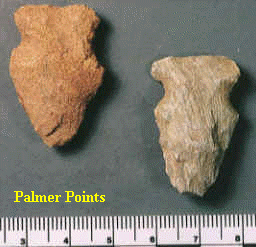
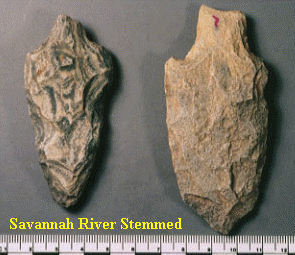
During this time, the Indians continued to be characterized by small
kinship-based nomadic groups which frequently moved in search of food. It is
clear that the aboriginal population began to increase and sites
representing this cultural period are found throughout our state. Late in
this period some groups began to inhabit the Savannah River basin to exploit
the freshwater shellfish, while other groups were gradually adapting to life
along the coast.
The Indians continued to use spear points, although their form slowly
changed from thin, corner-notched types, called Palmer and Kirk by
archaeologists, to broad stemmed points called Stanly and Savannah River
Stemmed. Other stone tools included knives, scrapers, grooved axes, drills,
and grinding stones. Bone awls, needles, and projectile points were also
common tools. A major technological change was the introduction of the
atlatl, or throwing stick, which helped the Indians propel their spears with
great force and accuracy. The introduction of carved soapstone bowls late in
this period, indicates that the nomadic lifestyle was becoming more
sedentary.
The Woodland Period
Indians (2,000 B.C. to A.D. 1000)
About 3,500 years ago, many new developments began among South Carolina's
native population. Along the coast of our State, Indians began to produce
the first fired pottery in North America. This pottery, called Stallings,
was tempered with Spanish moss and is often called "fiber-tempered." In
addition, a number of groups along the coast began to more permanently
settle at specific sites to exploit the rich coastal environment.
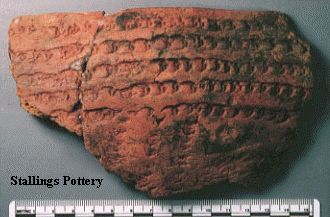

These people gathered plant foods, fished, collected shellfish, and
hunted. The sites where they lived, known today as "shell rings" are large
doughnut-shaped accumulations of shell, bone, and other refuse.
Some Indian groups probably developed seasonal rounds, moving to
different areas during different times of the year, to exploit specific
resources such as wild plant food or small game. They continued to make
pottery and the changes in the temper and decorations on this pottery allows
archaeologists to date, often within a few hundred years, the different
groups. Late during the Woodland
Period some Indian groups began to establish true villages. A few
groups were influenced by the religious practices of the Ohio Valley Indians
and began to bury their dead under mounds of earth.
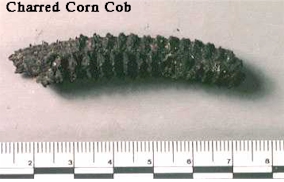 The Mississippian
Period Indians (A.D. 1000 to 1600) The Mississippian
Period Indians (A.D. 1000 to 1600)
By A.D. 1200 another major change was already taking place. Influenced by
cultures to the west, some Indian groups were adopting a new way of life,
often referred to as Mississippian.
Agriculture, emphasizing corn, beans, and squash, was introduced, and the
groups began to build large platform mounds with temples on the top. Groups
came together in chiefdoms to live in villages near these mounds. The bow
and arrow began to be used and projectile points became small and triangular
shaped (actually this may have even occurred earlier, in the Woodland
Period).
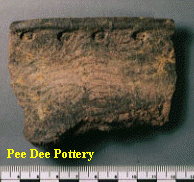

Several of these large village and mound complexes have been studied in
South Carolina. Perhaps the best known, Town Creek, is in North Carolina
and is operated as a state park by the North Carolina Department of Historic
Sites.
The Historic Period
(A.D. 1600 to the present)
The Historic Period in South Carolina begins with the arrival of Spanish
explorers and the English settlement of Charles Town in 1670. the rapid
expansion by Euro-Americans led to the destruction of most Native American
cultures in South Carolina. The Indians were displaced from their homeland,
decimated by European disease and large numbers were exported as slaves.
Within 50 years very few Indians were left on the South Carolina coast; only
a few small enclaves on the coast survived by becoming what were known as
"settlement Indians," or groups that adopted European ways and lived under
the shadow of a European settlement. Inland only the larger groups, such as
Catawba and Cherokee survived the onslaught of the Europeans and their
diseases.


The rich and varied history of South Carolina from about A.D. 1670 to the
early twentieth century may be divided between the Colonial, Antebellum, and
Postbellum periods. The study of such varied sites as farmsteads, urban
houses and shops, plantation slave rows, and industrial sites helps us
obtain a better understanding of early Carolina lifeways.
|